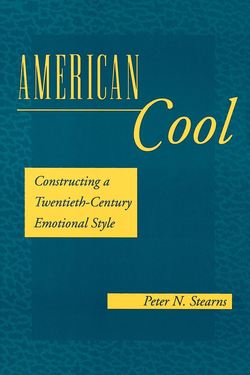Читать книгу American Cool - Peter N. Stearns - Страница 13
На сайте Литреса книга снята с продажи.
Grief
ОглавлениеVictorian engagement with emotional intensity showed clearly in the embrace of grief. Grief was, in the first place, a vital component in the cultural arsenal. It was frequently discussed, a staple not only of story but also of song. Grief was heartrending, as Paul Rosenblatt has demonstrated.46 The depth of grief followed directly, in fact, from the emphasis on great love, for Victorian convention held that even the temporary absence of a loved one was a real sorrow. As Nathaniel Hawthorne put it in a letter to Sarah Peabody in 1840: “Where thou art not, there it is a sort of death.” Death itself, correspondingly, would move one to the core. Despite its pain, the essence of grief was a vital part of Victorian emotional life. Children were prepared for it by frequent references, while adults developed various conventions to permit its open expression. In its intensity and its link to love, grief indeed could have a bittersweet quality: immensely sad, but almost a welcome part of a full emotional experience. It could express and enrich the very love Victorian culture sought. As a Protestant minister put it in a family advice manual of 1882: “It may truly be said that no home ever reaches its highest blessedness and sweetness of love and its richest fullness of joy till sorrow enters its life in some way.”47
Efforts to present grief and death to children in a benign though sorrowful context continued through the later nineteenth century.48 In McGuffy’s Fourth Eclectic Reader (1866), sixteen of twenty-nine “poetical lessons” dealt with death, including one entitled “What Is Death?”:
Child. Mother, how still the baby lies.
I cannot hear his breath;
I cannot see his laughing eyes;
They tell me this is death.
They say that he again will rise,
More beautiful than now;
That God will bless him in the skies;
O mother, tell me how.
In this case, the mother responds with the image of a butterfly emerging from a lifeless chrysalis. In other poems, again in school readers, the dominant theme was the reunion of loved ones after death in heaven.
Oh. we pray to meet our darling
For a long, long, sweet embrace.
Where the little feet are waiting—
And we meet her face to face.
Tragic death scenes remained commonplace in stories for children, as they were asked to live through the sorrows of illness and passing while being assured that an outpouring of emotion was valid and ultimately healthy: “Elsie’s grief was deep and lasting. She sorrowed as she might have done for the loss of a very dear brother, … a half remorseful feeling which reason could not control or entirely relieve; and it was long ere she was quite her own bright, gladsome sunny self again.” Louisa May Alcott wrote of a sister’s “bitter cry of an unsubmissive sorrow,” of “sacred moments, when heart talked to heart in the silence of the night, turning affliction to a blessing, which chastened grief and strengthened love.”49 Mother’s assurances, repeated references to protecting angels, and the increasing theme of familial reunion in heaven all linked the power of grief to hope and love; but the power was not evaded. Stories of death were now disengaged from fear and from moral admonitions about life’s transiency to become part of the characteristic Victorian emotional style, in which intense emotions served as a desirable part of life and, ultimately, an enhancement of human ties. The starkness of death disappeared under sentimental overlays in these portrayals, but the inescapability, even the benefit, of a period of deep grief was generally confirmed.
The same themes pervaded popular parlor songs in the Victorian decades. The 1839 song “Near the Lake Where Droop’d the Willow” became an immense success in American concerts and inspired several decades of imitations. The song focused on a girl loved in youth, who had died long ago:
Mingled were our hearts forever, long time ago;
Can I now forget her? Never. No, lost one, no.
To her grave these tears are given, ever to flow,
She’s the star I missed from heaven, long time ago.50
In contrast to eighteenth-century songs about death, which were set in the artificial pastoral world of shepherds and written in the third person, Victorian grief songs were personal and immediate. Death and its aftermath became a field for emotional exploration. Minstrel shows dealt with the emotions of death, often without much reference to plot or character. Deathbed scenes, the emotional ties between dead and living, and the idea of ultimate reunion in heaven all figured prominently. Literally hundreds of songs about dying girls were published, particularly in the 1860s, when they obviously served as a combination of focus for and distraction from the terrors of the Civil War: “Wait for me at heaven’s gate, Sweet Belle Mahone”; “Though we may meet no more on earth, Thou shalt be mine above”; “Angels guard her with your wings. … Bid her dream love-dreams of me—Till I come, sleep, Eulalie.” But along with the sentimentalized heaven came real sorrow on earth, with frequent emotion-laden visits to the cemetery: “I’m kneeling by thy grave, Katy Darling; This world is all a bleak place to me”; “All night I sat upon her grave, And sorely I did cry.”51
Oh, a huge great grief I’m bearing,
Though I scarce can heave a sigh,
And I’ll ever be dreaming, Katy Darling,
Of. thy love ev’ry day till I die.52
The pervasive themes of grief and pathos formed an important part of Victorian culture, making the sorrow of bereavement seem natural, even desirable, though also to some degree consolable. Grief could soar, as love did. At the risk of trivializing grief (and certainly Christian doctrines concerning the afterlife), Victorian emotional culture embraced this sorrow openly, returning to it with almost endless fascination at least until the final decades of the nineteenth century.
